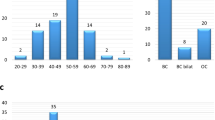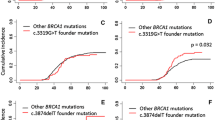Abstract
We have performed screening in 287 breast/ovarian cancer families in Greece which has revealed that ∼12% (8/65) of all index patients-carriers of a deleterious mutation in BRCA1 and BRCA2 genes, contain the base substitution G to A at position 5331 of BRCA1 gene. This generates the amino acid change G1738R for which based on a combination of genetic, in silico and histopathological analysis there are strong suggestions that it is a causative mutation. In this paper, we present further evidence suggesting the pathogenicity of this variant. Forty breast/ovarian cancer patients were reported in 11 Greek families: the above eight living in Greece, two living in Australia and one in USA, all containing G1738R. Twenty of these patients were screened and were all found to be carriers of the same base substitution. In addition, we have detected the same base change in five breast/ovarian cancer patients after screening 475 unselected patient samples with no apparent family history. The mean age of onset for all the above patients was 39.4 and 53.6 years for breast and ovarian cancer cases, respectively. A multi-factorial likelihood model for classification of unclassified variants in BRCA1 and BRCA2 developed previously was applied on G1738R and the odds of it being a deleterious mutation was estimated to be 11470:1. In order to explain the prevalence of this mutation mainly in the Greek population, its genealogical history was examined. DNA samples were collected from 11 carrier families living in Greece, Australia and USA. Screening of eight intragenic SNPs, three intragenic and seven extragenic microsatellite markers and comparison with control individuals, suggested a common origin for the mutation while the time to its most recent common ancestor was estimated to be 11 generations (about 275 years assuming a generational interval of 25 years) with a 1-lod support interval of 4–24 generations (100–600 years). Considering the large degree of genetic heterogeneity in the Greek population, the identification of a frequent founder mutation greatly facilitates genetic screening.


Similar content being viewed by others
References
Easton DF, Pooley KA, Dunning AM et al (2007) Genome-wide association study identifies novel breast cancer susceptibility loci. Nature 447:1087–1093
Tonin P, Serova O, Lenoir G et al (1995) BRCA1 mutations in Ashkenazi Jewish women. Am J Hum Genet 57:189
Durocher F, Tonin P, Shattuck-Eidens D et al (1996) Mutation analysis of the BRCA1 gene in 23 families with cases of cancer of the breast, ovary, and multiple other sites. J Med Genet 33:814–819
Tonin PN, Mes-Masson AM, Futreal PA et al (1998) Founder BRCA1 and BRCA2 mutations in French Canadian breast and ovarian cancer families. Am J Hum Genet 63:1341–1351
Dorum A, Hovig E, Trope C et al (1999) Three per cent of Norwegian ovarian cancers are caused by BRCA1 1675delA or 1135insA. Eur J Cancer 35:779–781
Peelen T, Cornelis RS, van Vliet M et al (1996) The majority of 22 Dutch high-risk breast cancer families are due to either BRCA1 or BRCA2. Eur J Hum Genet 4:225–230
Petrij-Bosch A, Peelen T, van Vliet M et al (1997) BRCA1 genomic deletions are major founder mutations in Dutch breast cancer patients. Nat Genet 17:341–345
Gorski B, Jakubowska A, Huzarski T et al (2004) A high proportion of founder BRCA1 mutations in Polish breast cancer families. Int J Cancer 110:683–686
Konstantopoulou I, Rampias T, Ladopoulou A et al (2007) Greek BRCA1 and BRCA2 mutation spectrum: two BRCA1 mutations account for half the carriers found among high-risk breast/ovarian cancer patients. Breast Cancer Res Treat [Epub ahead of print]
Williams RS, Chasman DI, Hau DD et al (2003) Detection of protein folding defects caused by BRCA1-BRCT truncation and missense mutations. J Biol Chem 278:53007–53016
Glover JN (2006) Insights into the molecular basis of human hereditary breast cancer from studies of the BRCA1 BRCT domain. Fam Cancer 5:89–93
Mirkovic N, Marti-Renom MA, Weber BL et al (2004) Structure-based assessment of missense mutations in human BRCA1: implications for breast and ovarian cancer predisposition. Cancer Res 64:3790–3797
Chenevix-Trench G, Healey S, Lakhani S et al (2006) Genetic and histopathologic evaluation of BRCA1 and BRCA2 DNA sequence variants of unknown clinical significance. Cancer Res 66:2019–2027
Joo WS, Jeffrey PD, Cantor SB et al (2002) Structure of the 53BP1 BRCT region bound to p53 and its comparison to the Brca1 BRCT structure. Genes Dev 16:583–593
Abkevich V, Zharkikh A, Deffenbaugh AM et al (2004) Analysis of missense variation in human BRCA1 in the context of interspecific sequence variation. J Med Genet 41:492–507
Karchin R, Monteiro AN, Tavtigian SV et al (2007) Functional impact of missense variants in BRCA1 predicted by supervised learning. PLoS Comput Biol 3:e26
Carvalho MA, Marsillac SM, Karchin R et al (2007) Determination of cancer risk associated with germ line BRCA1 missense variants by functional analysis. Cancer Res 67:1494–1501
Goldgar DE, Easton DF, Deffenbaugh AM et al (2004) Integrated evaluation of DNA sequence variants of unknown clinical significance: application to BRCA1 and BRCA2. Am J Hum Genet 75:535–544
Miller SA, Dykes DD, Polesky HF (1988) A simple salting out procedure for extracting DNA from human nucleated cells. Nucleic Acids Res 16:1215
Ladopoulou A, Kroupis C, Konstantopoulou I et al (2002) Germ line BRCA1 and BRCA2 mutations in Greek breast/ovarian cancer families: 5382insC is the most frequent mutation observed. Cancer Lett 185:61–70
Armaou S, Konstantopoulou I, Anagnostopoulos T et al (2007) Novel genomic rearrangements in the BRCA1 gene detected in Greek breast/ovarian cancer patients. Eur J Cancer 43:443–453
Thompson D, Easton DF, Goldgar DE (2003) A full-likelihood method for the evaluation of causality of sequence variants from family data. Am J Hum Genet 73:652–655
Antoniou A, Pharoah PD, Narod S et al (2003) Average risks of breast and ovarian cancer associated with BRCA1 or BRCA2 mutations detected in case Series unselected for family history: a combined analysis of 22 studies. Am J Hum Genet 72:1117–1130
Neuhausen SL, Godwin AK, Gershoni-Baruch R et al (1998) Haplotype and phenotype analysis of nine recurrent BRCA2 mutations in 111 families: results of an international study. Am J Hum Genet 62:1381–1388
Neuhausen SL, Mazoyer S, Friedman L et al (1996) Haplotype and phenotype analysis of six recurrent BRCA1 mutations in 61 families: results of an international study. Am J Hum Genet 58:271–280
Weber JL, Wong C (1993) Mutation of human short tandem repeats. Hum Mol Genet 2:1123–1128
Judkins T, Hendrickson BC, Deffenbaugh AM et al (2005) Application of embryonic lethal or other obvious phenotypes to characterize the clinical significance of genetic variants found in trans with known deleterious mutations. Cancer Res 65:10096–10103
Ekblad CM, Wilkinson HR, Schymkowitz JW et al (2002) Characterisation of the BRCT domains of the breast cancer susceptibility gene product BRCA1. J Mol Biol 320:431–442
Pyrpassopoulos S, Ladopoulou A, Vlassi M et al (2005) Thermal denaturation of the BRCT tandem repeat region of human tumour suppressor gene product BRCA1. Biophys Chem 114:1–12
Williams RS, Lee MS, Hau DD et al (2004) Structural basis of phosphopeptide recognition by the BRCT domain of BRCA1. Nat Struct Mol Biol 11:519–525
Nikolopoulos G, Pyrpassopoulos S, Thanassoulas A et al (2007) Thermal unfolding of human BRCA1 BRCT-domain variants. Biochim Biophys Acta 1774:772–780
Liu X, Barker DF (1999) Evidence for effective suppression of recombination in the chromosome 17q21 segment spanning RNU2-BRCA1. Am J Hum Genet 64:1427–1439
Acknowledgements
We are indebted to the patients for their collaboration in this study. This work was partly supported by the Hellenic Cooperative Oncology Group (HeCOG), the Greek Ministry of Health and Welfare (MOHAW), the Hellenic Institute for Occupational Health and Safety, the IST-2004-NEMOSLAB 027804 program and the Greek General Secretary for Research and Technology (GSRT) Program, Research in Excellence II and 05NONEU21, funded by 75% from the European Union.
Author information
Authors and Affiliations
Corresponding author
Rights and permissions
About this article
Cite this article
Anagnostopoulos, T., Pertesi, M., Konstantopoulou, I. et al. G1738R is a BRCA1 founder mutation in Greek breast/ovarian cancer patients: evaluation of its pathogenicity and inferences on its genealogical history. Breast Cancer Res Treat 110, 377–385 (2008). https://doi.org/10.1007/s10549-007-9729-y
Received:
Accepted:
Published:
Issue Date:
DOI: https://doi.org/10.1007/s10549-007-9729-y




